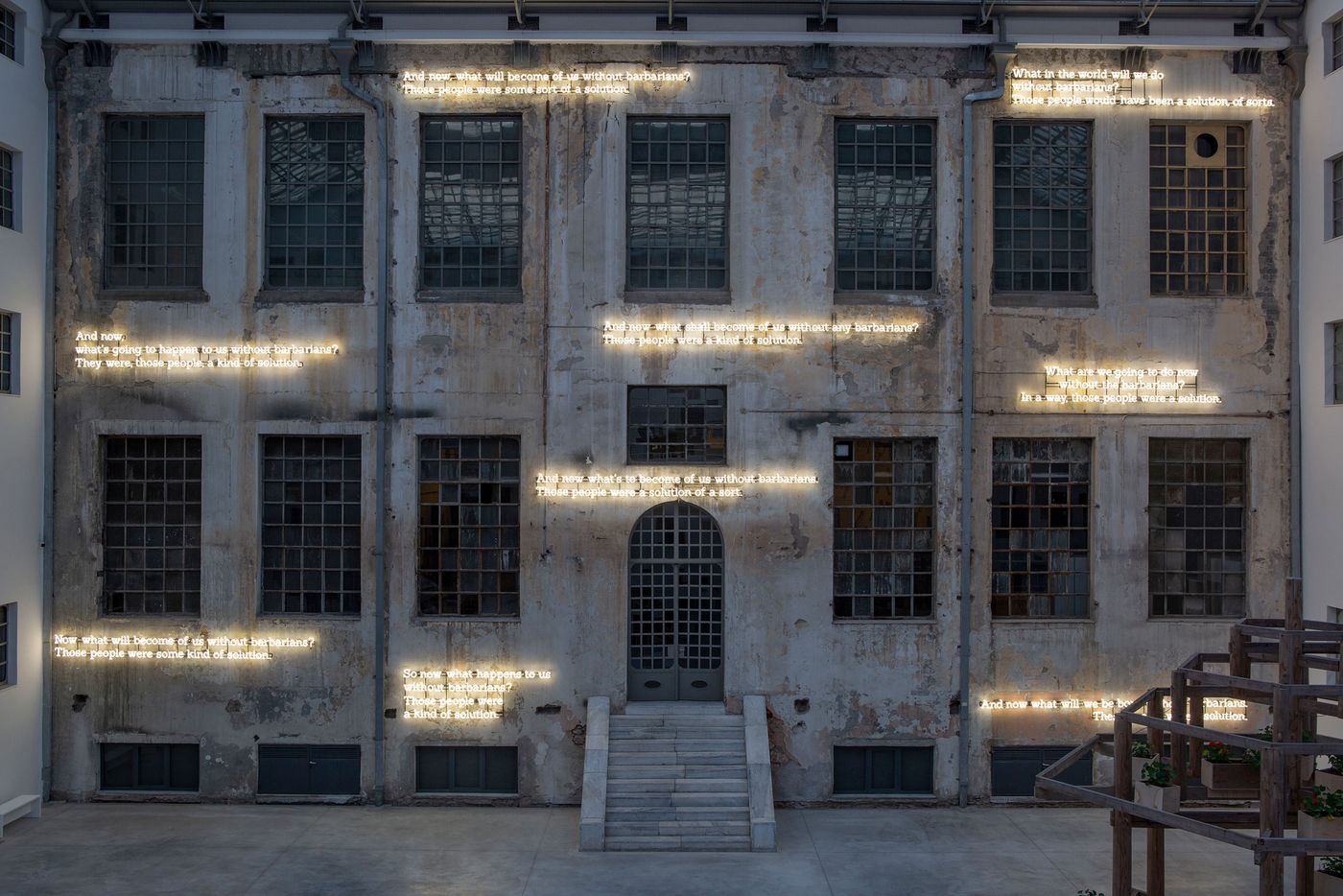
PORTALS: An Industrial Landmark Turned Culture Hub in Athens Hosts an Aspirational Group Exhibition by NEON
Words by Eric David
Location
Athens, Greece
PORTALS: An Industrial Landmark Turned Culture Hub in Athens Hosts an Aspirational Group Exhibition by NEON
Words by Eric David
Athens, Greece
Athens, Greece
Location
Since its launch in 2013, NEON, a Greek non-profit organization whose primary mission is to bring contemporary art closer to the public, has been breathing new life into numerous sites across Athens and beyond, from archaeological sites, to private gardens, to abandoned buildings, by organizing exhibitions that allow visitors to experience them afresh. NEON’s latest and most ambitious project is the transformation of the former Public Tobacco Factory, an iconic interwar building in the heart of Athens, into a new 6,500 square-metre cultural space. Founded by NEON and organized in collaboration with the Hellenic Parliament, the project commemorates the 200th anniversary of the Greek War of Independence as well as living through the pandemic. Inaugurating the new space, which opened its doors to the public last week, “Portals” is an international group exhibition curated by NEON's Director Elina Kountouri and Pritzker Director of Museum of Contemporary Art Chicago Madeleine Grynsztejn that brings together 59 artists from 27 countries, including 15 new site-specific installations commissioned especially by NEON, whose diverse cultural backgrounds offer a plurality of ideas underpinned by a shared aspiration to create a portal into a new, more humane and inclusive reality.
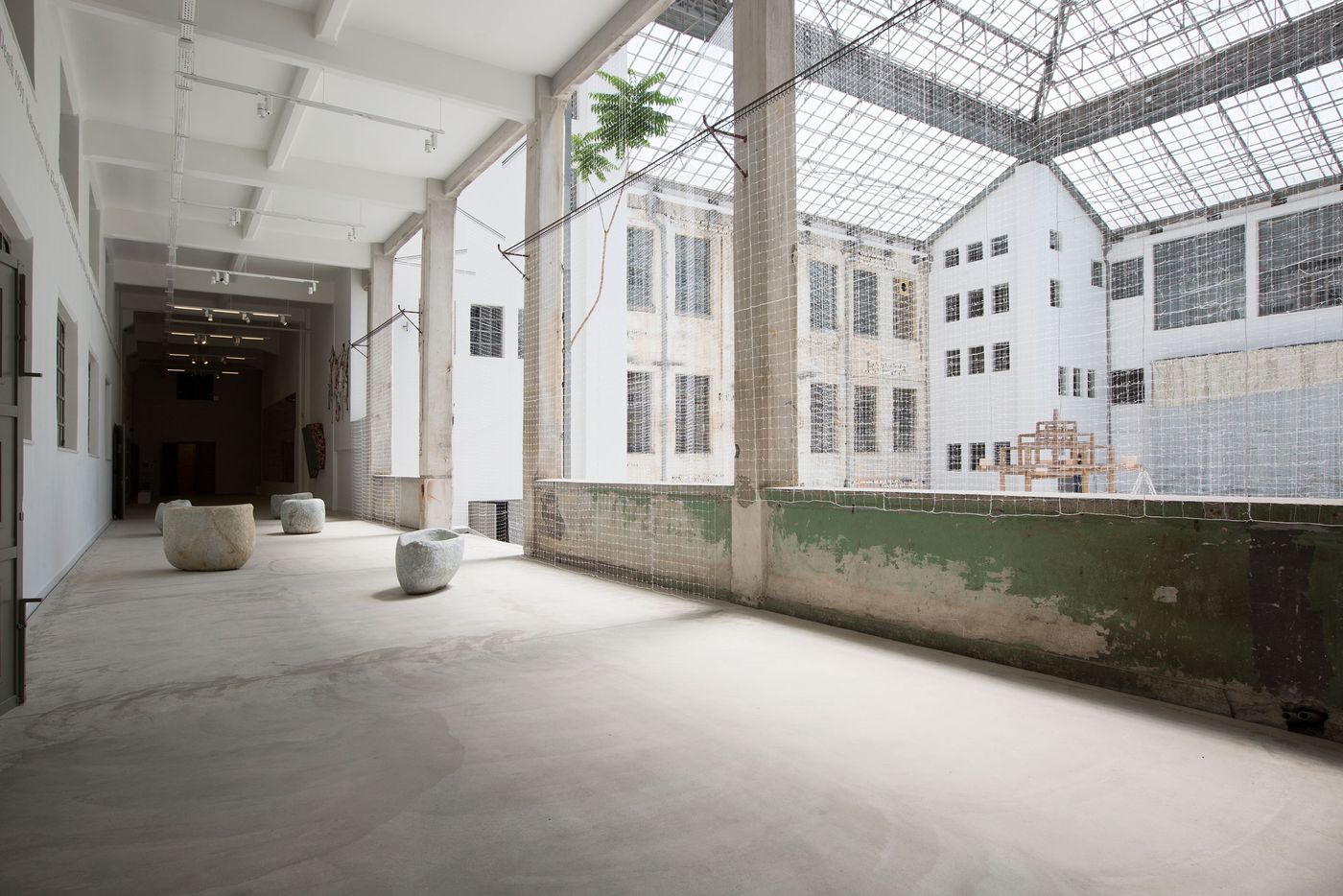
Installation View Portals, Hellenic Parliament + NEON at the former Public Tobacco Factory, Photography © Natalia Tsoukala. Courtesy NEON
Featured (from left): Solange Pessoa, Untitled, 2013. Soapstone. Courtesy the artist and Mendes Wood DM São Paulo, New York, Brussels.Maria Loizidou, A Monumental Lightness, 2021. Cotton, linen, silk threads and metal. 12.20 × 19.80 × 7.80 m. Courtesy the artist and Kalfayan Galleries, Athens - Thessaloniki Commissioned by NEON.
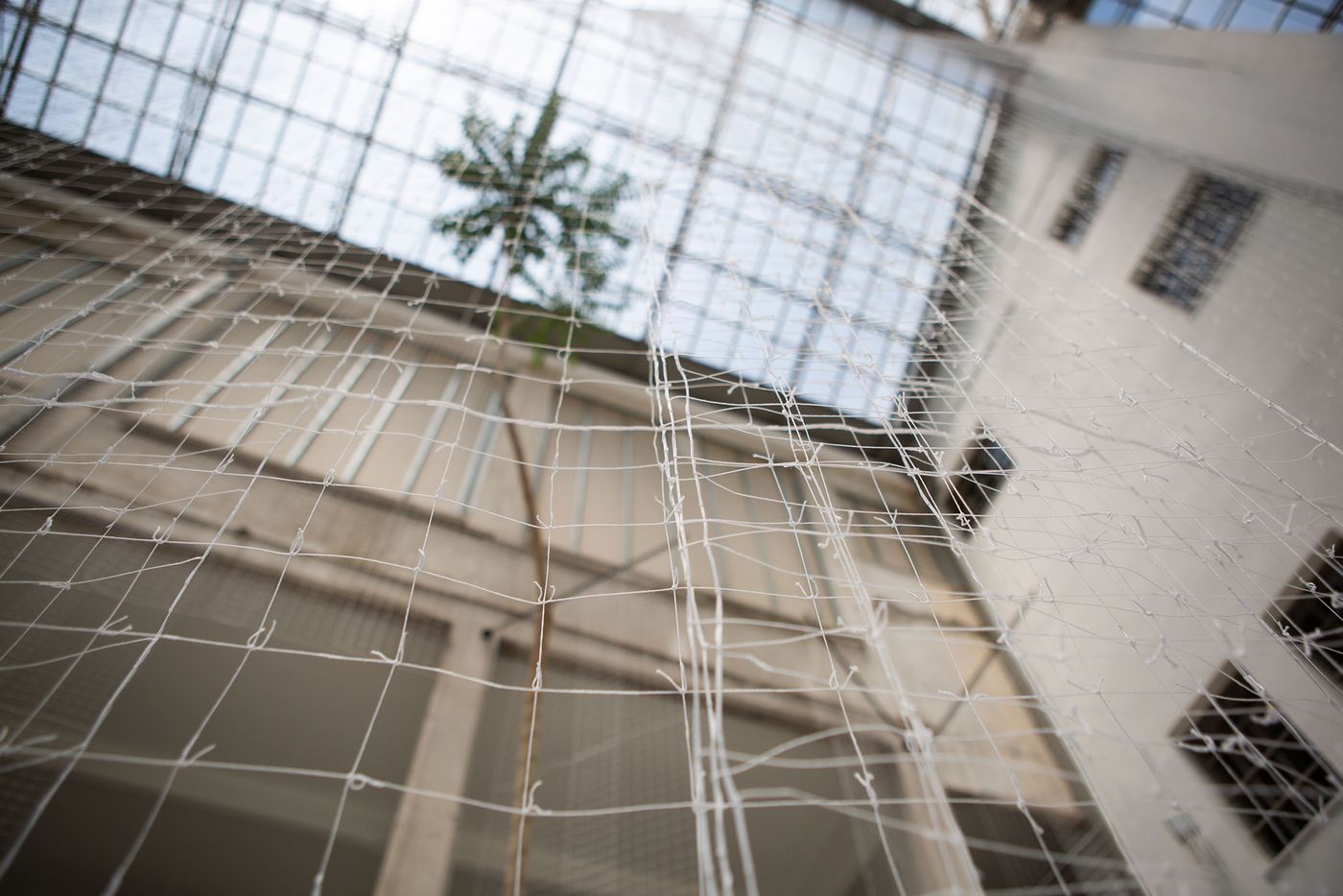
Installation View Portals, Hellenic Parliament + NEON at the former Public Tobacco Factory, Photography © Natalia Tsoukala. Courtesy NEON
Featured: Maria Loizidou, A Monumental Lightness (detail), 2021. Cotton, linen, silk threads and metal. 12.20 × 19.80 × 7.80 m. Courtesy the artist and Kalfayan Galleries, Athens - Thessaloniki Commissioned by NEON.

Installation View Portals, Hellenic Parliament + NEON at the former Public Tobacco Factory, Photography © Natalia Tsoukala. Courtesy NEON
Featured (from left): Adriana Varejão, Ruina de Charque Lapa, 2001. Oil on wood and polyurethane. 176 × 175 × 40 cm. D.Daskalopoulos Collection. Sonia Gomes, Magia, 2014. Stitching, knots, different fabrics, laces and fragments. 215 × 240 cm. Courtesy the artist and Mendes Wood DM São Paulo, Brussels, New York / Copyright of the artist. Solange Pessoa, Untitled, 2013. Soapstone. Courtesy the artist and Mendes Wood DM São Paulo, New York, Brussels.
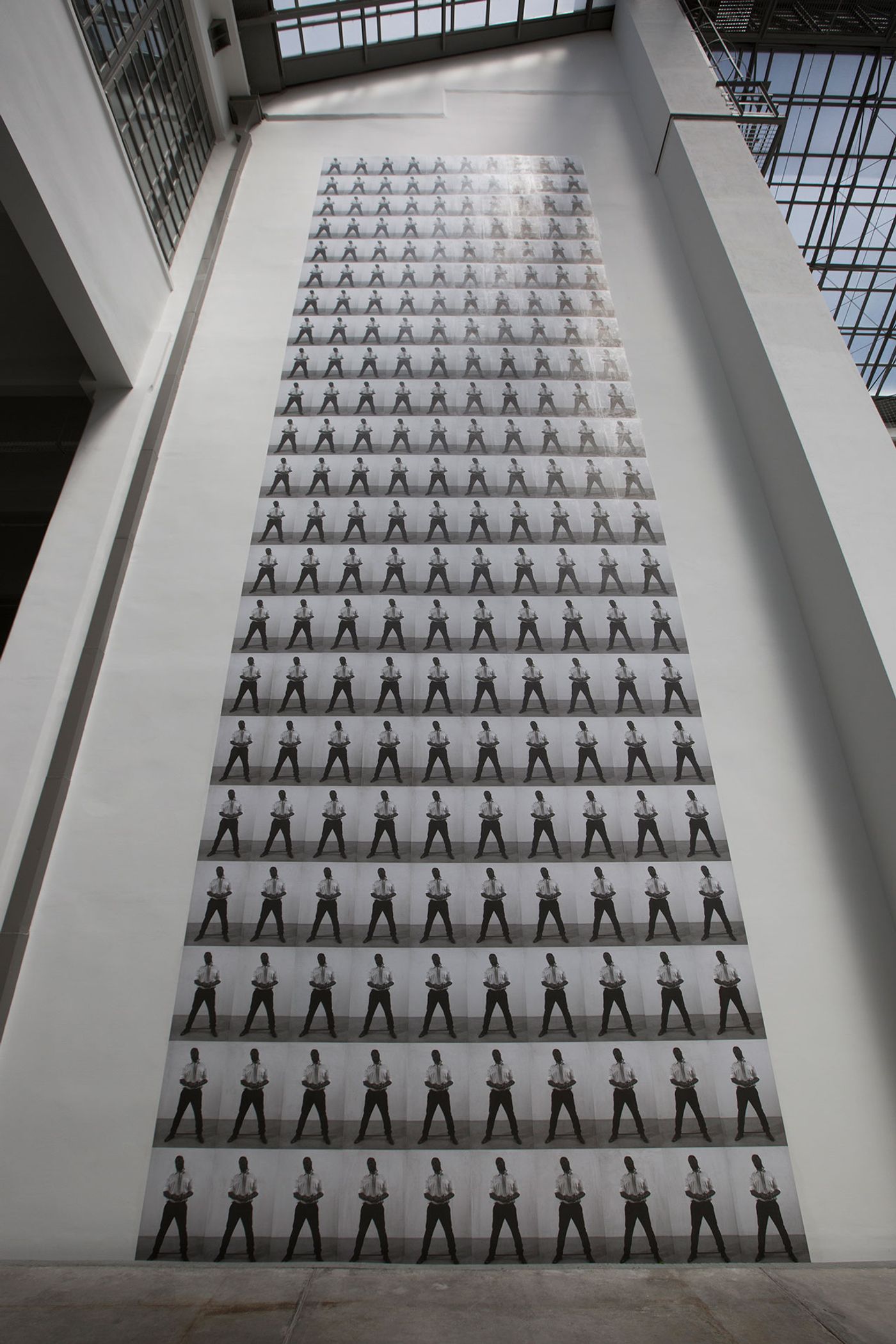
Installation View Portals, Hellenic Parliament + NEON at the former Public Tobacco Factory, Photography © Natalia Tsoukala. Courtesy NEON
Featured: Steve McQueen, Portrait as an Escapologist, 2006. 220 black-and-white offset prints 60 × 40 cm each. Courtesy the artist and Thomas Dane Gallery.
The choice of the former Public Tobacco Factory to host the exhibition goes beyond its architectural merits – the landmarked building is a paradigm of interwar industrial architecture – being more related to the building’s history which goes hand in hand with the country’s socio-political trajectory over the course of the 20th century. Inaugurated in 1930, the enormous 19,000 square-metre building was home to numerous tobacco factories, warehouses and a customs office, at a time when tobacco processing and cigarette production spearheaded the development of the country’s industry, commerce and banking sectors.
The building later served as a prison, refugee shelter and workplace for several government agencies, before being granted to the Hellenic Parliament in 2000 to house part of the Parliament’s library and printing press.
From a key cog in the country’s 20th century economy, to a token of the ever-expanding state apparatus, to a repository of the country’s democratic institutions, to a contemporary culture venue, courtesy of NEON, the building is in effect a brick and mortars X-ray of modern Greek society. As such, it’s the perfect venue for a group of artists who critically look to the past in order to “become witnesses to and agents for the laying out of a possible new normal” in the words of co-curator Elina Kountouri.

Installation View Portals, Hellenic Parliament + NEON at the former Public Tobacco Factory, Photography © Natalia Tsoukala. Courtesy NEON.
Featured (from left): Marisa Merz, Untitled, n.d. Unfired and painted clay. 14 × 14 × 17 cm. Courtesy Bernier/Eliades Gallery Marisa Merz, Untitled, 1980's-1990's. White raw clay. 28 × 20 × 12 cm. Private collection, Athens. Marisa Merz, Untitled (Head Gold), 1980's-1990's. Gold painted clay, tripod. 22 × 10 × 14 cm. Private collection, Athens.

Installation View Portals, Hellenic Parliament + NEON at the former Public Tobacco Factory, Photography © Natalia Tsoukala. Courtesy NEON
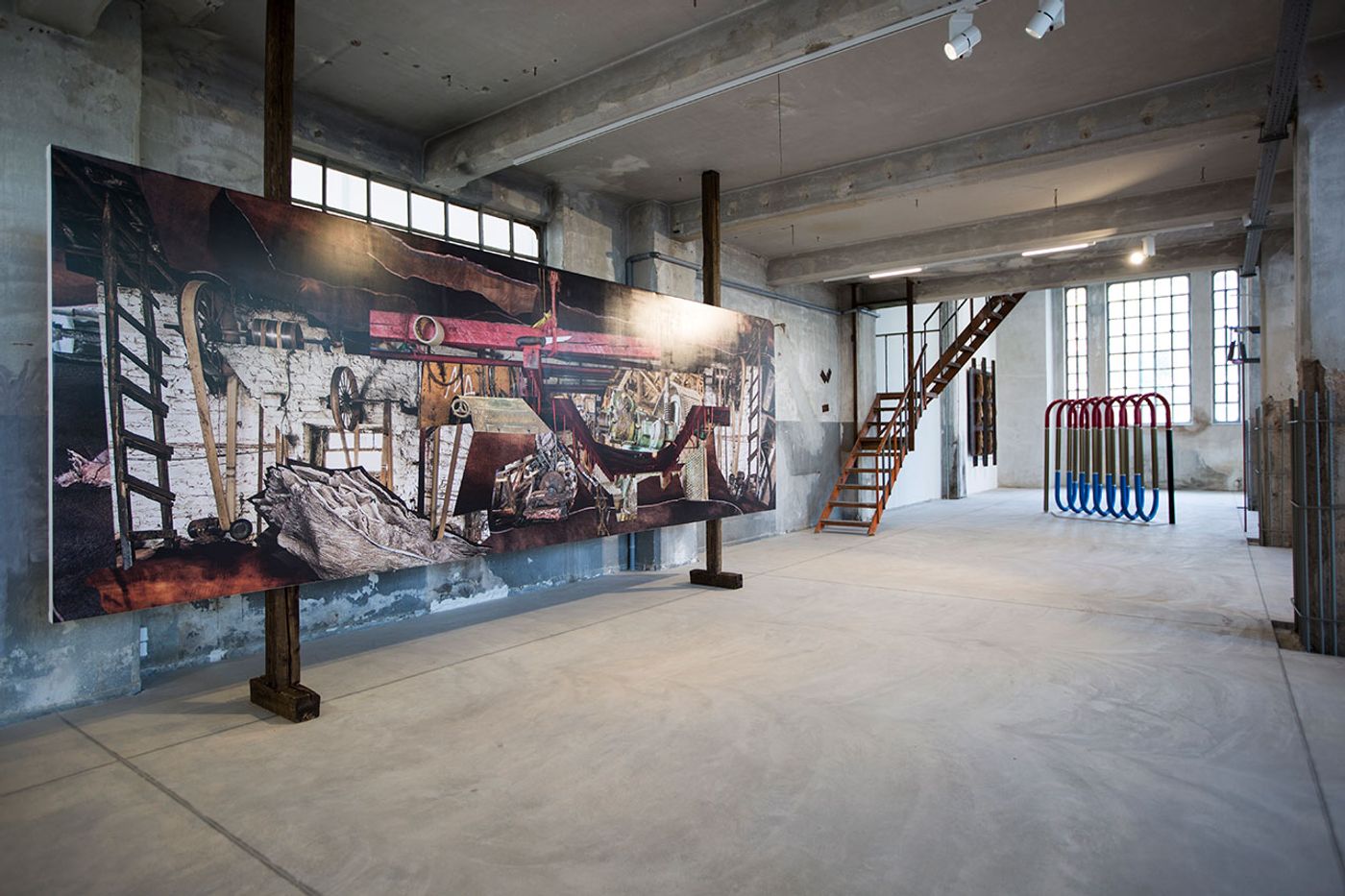
Installation View Portals, Hellenic Parliament + NEON at the former Public Tobacco Factory, Photography © Natalia Tsoukala. Courtesy NEON
Featured (from left): Maria Papadimitriou, My Soul My Beast (Portable Monument of Animality), 2016. Mixed media 5.5 × 1.8 m (approx.). Edition 2021 Courtesy the artist, NEON. Anastasia Douka, Anger organizes, 2021. Anodized aluminum, car spray paint, polyethylene. Dimensions variable. Courtesy the artist Commissioned by NEON.
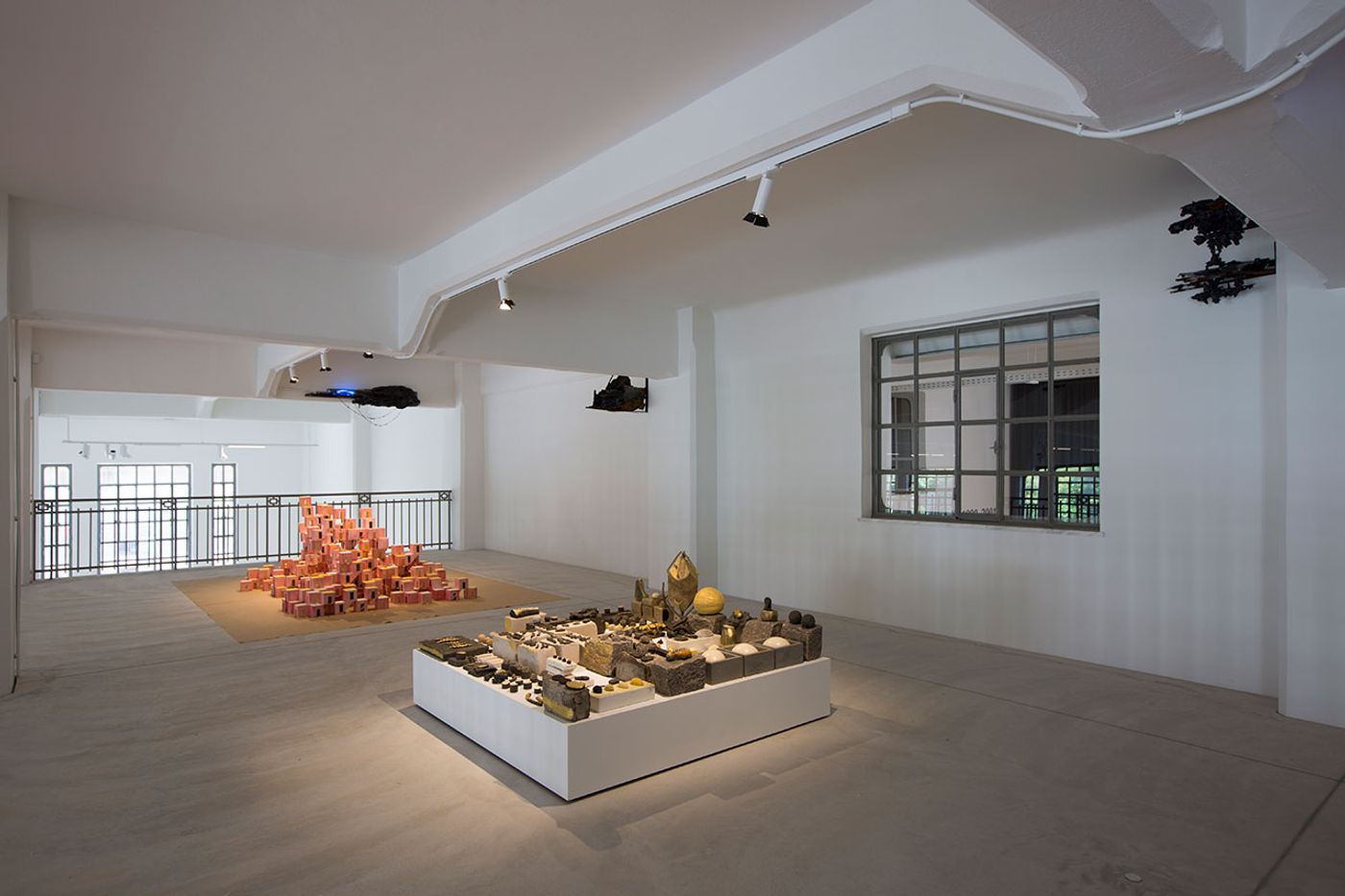
Installation View Portals, Hellenic Parliament + NEON at the former Public Tobacco Factory, Photography © Natalia Tsoukala. Courtesy NEON
Featured (front to back): Erika Verzutti, Cemetery of Yellows, 2019. Clay, concrete, bronze, stones. 28 × 150 × 150 cm. Courtesy of Alison Jacques, London. Nikos Alexiou, Fear, 2003. Watercolor on paper. Dimensions variable Private Collection, Athens. Alexandros Tzannis, Interference, Noise and Message (The Parasite Series), 2020-2021. Iron, rust, magnets, neodymium magnets, glass, ceramic, bronze, neon light, iron pyrite, lepidolite, azurite. Dimensions variable. Courtesy the artist Commissioned by NEON.
The concept of a ‘new normal’ lies at the conceptual heart of Portals. Going back to ‘normal’ is not only impossible, but undesirable, as outlined by Indian author Arundhati Roy in her 2000 Financial Times essay “The pandemic is a portal” that serves as the exhibition’s inspiration. “The pandemic is a portal, a gateway between one world and the next”, she writes. “We can choose to walk through it, dragging the carcasses of our prejudice and hatred, our avarice, our data banks and dead ideas, our dead rivers and smoky skies behind us. Or we can walk through lightly, with little luggage, ready to imagine another world.” Roy’s manifesto is echoed by the exhibition’s participating artists whose work address outdated and problematic ideas, customs and practices related to collectivity, cultural understanding of history and politics, public space, and our common past, present and future, as well as the exhibition’s set up.
Kountouri and Grynsztejn have taken advantage of the sprawling industrial premises to sparsely place the artworks throughout the building’s renovated areas, from the imposing atrium and spacious halls and lofts, to the former Customs Office, to the more confined corridors and bathrooms, giving visitors plenty of breathing space between exhibits to contemplate the possibilities looming on the other side of the portals the exhibition conjures without feeling overwhelmed or as if they are being preached to.
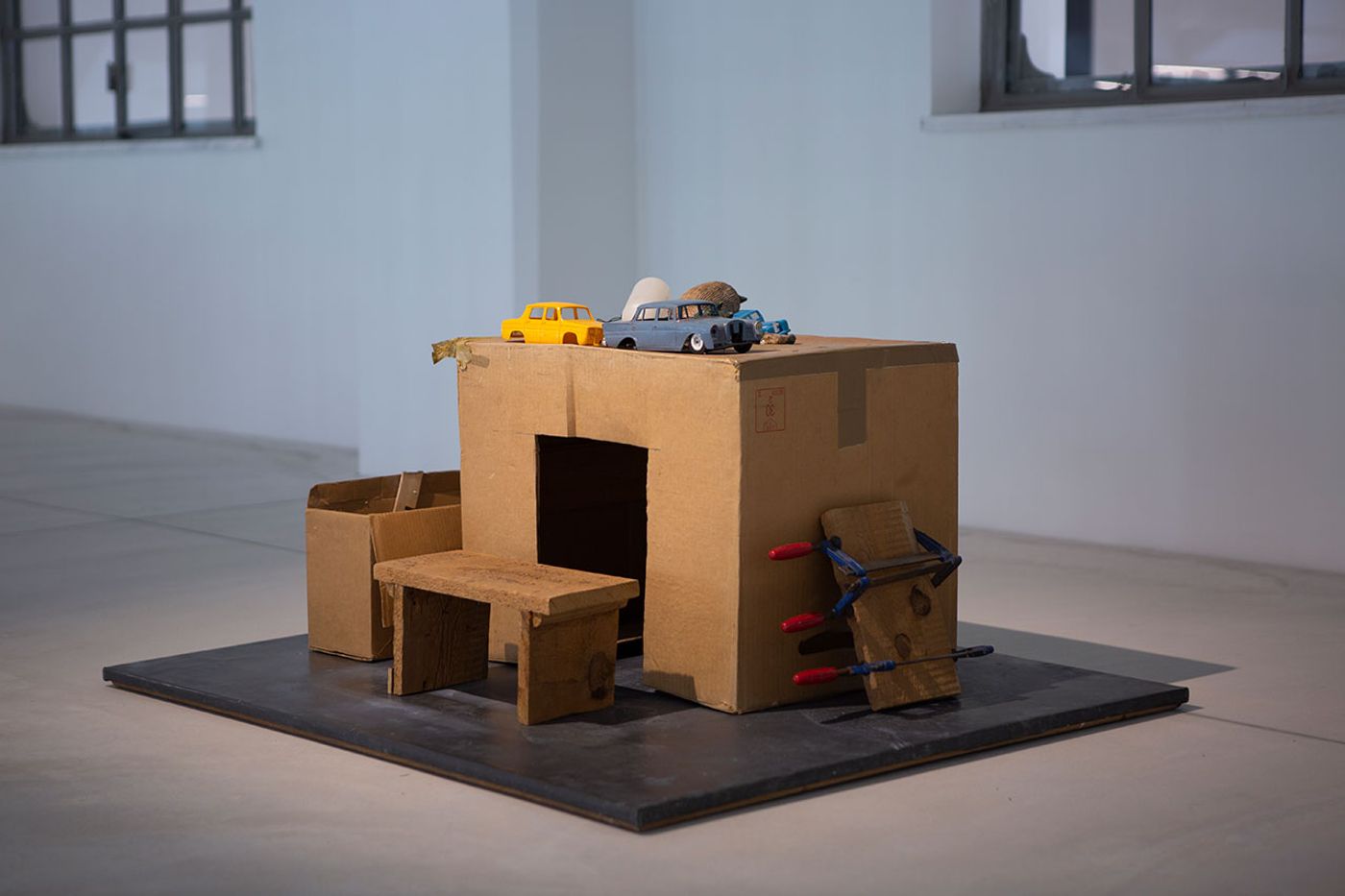
Installation View Portals, Hellenic Parliament + NEON at the former Public Tobacco Factory, Photography © Natalia Tsoukala. Courtesy NEON
Featured: Vlassis Caniaris, Child's Desk, 1972. Metal, wood, plastic, cardboard, paper (various materials). 60 × 120 × 94 cm. Private Collection. Courtesy Kalfayan Galleries, Athens - Thessaloniki.
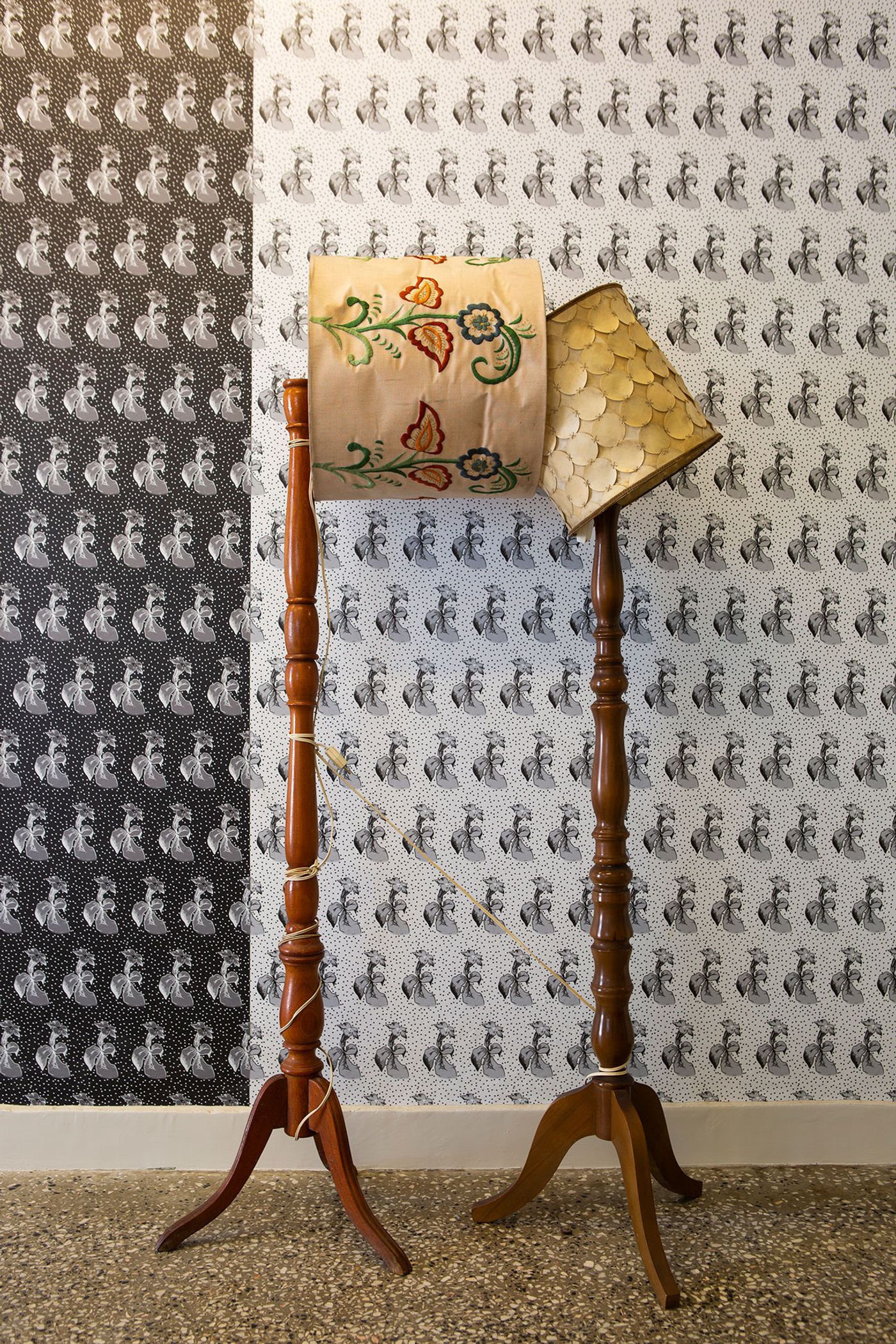
Installation View Portals, Hellenic Parliament + NEON at the former Public Tobacco Factory, Photography © Natalia Tsoukala. Courtesy NEON
Featured: Duro Olowu, Bound, Lost, Found, Heaven sent: A Trail of Objects (detail), 2021. Dimensions Variable. Courtesy the artist Commissioned by NEON.
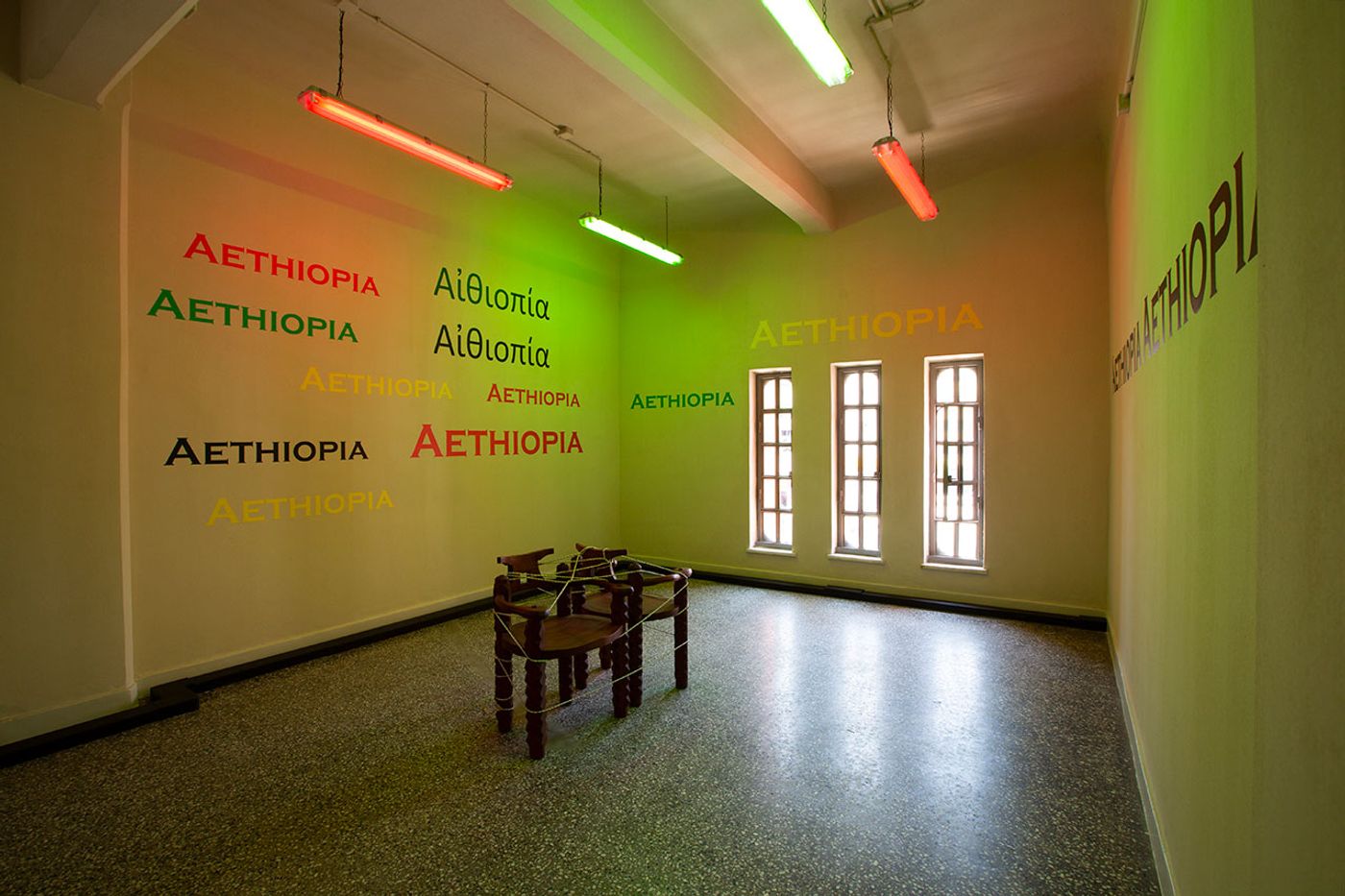
Installation View Portals, Hellenic Parliament + NEON at the former Public Tobacco Factory, Photography © Natalia Tsoukala. Courtesy NEON
Featured: Duro Olowu, Bound, Lost, Found, Heaven sent: A Trail of Objects (detail), 2021. Dimensions Variable. Courtesy the artist Commissioned by NEON.

Installation View Portals, Hellenic Parliament + NEON at the former Public Tobacco Factory, Photography © Natalia Tsoukala. Courtesy NEON
Featured: Ad Minoliti, Teteras, 2021. Wallpaper mural. 210 × 645 cm. Courtesy the artist Commissioned by NEON.

Installation View Portals, Hellenic Parliament + NEON at the former Public Tobacco Factory, Photography © Natalia Tsoukala. Courtesy NEON
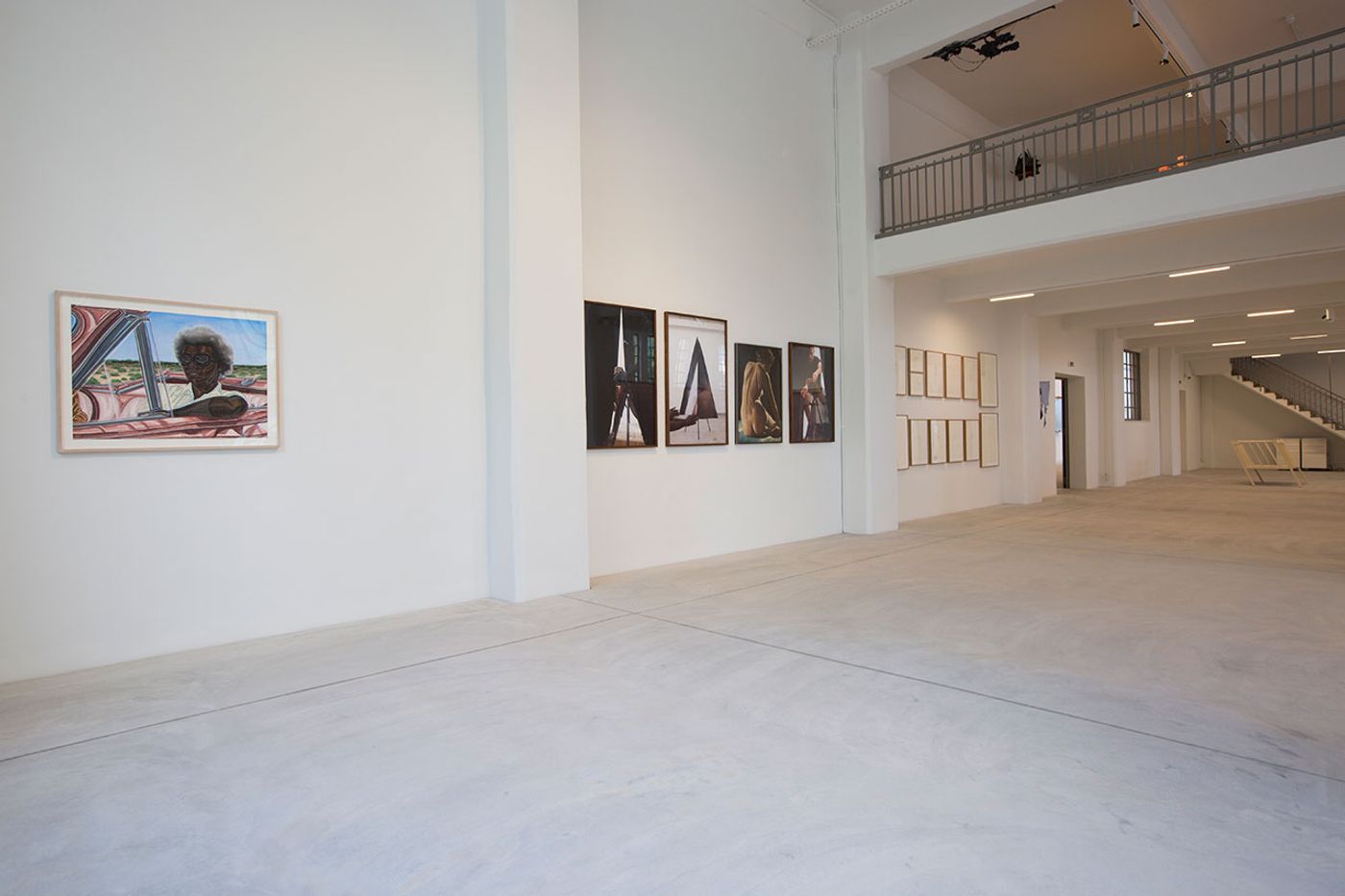
Installation View Portals, Hellenic Parliament + NEON at the former Public Tobacco Factory, Photography © Natalia Tsoukala. Courtesy NEON
The exhibition even extends to the building’s exterior and surrounding area, with Greek artist Nikos Navridis’ illuminated Samuel Beckett quote Try again. Fail again. Fail better. and Ever tried. Ever failed. No matter. mounted on the rooftop functioning in effect as both clarion calls and visual beacons. As visually mesmerizing and poetically instructive is Glenn Ligon’s Waiting for the Barbarians, an artistic take on Alexandrian Greek poet Constantine Kavafis’ famous poem of the same title inscribed in neon on one of the atrium’s facades. Commissioned by NEON, Ligon’s work encapsulates the poem’s timeless themes of cultural exhaustion, political inertia and societal navel-gazing by presenting nine alternative English translations of the poem’s most characteristic stanza that pose rhetorical yet poignant questions about our willingness and commitment to change.
Generously illuminated by the daylight flooding through the enormous glass roof, the atrium was conceived as a public space, an “agora” of ideas that envision, in the curators’ words, “a world in need of healing and unity”. Apart from Ligon’s work, the space also features photographic work by British filmmaker and artist Steve McQueen, a wall-mounted installation made from bottle caps by Ghana-born, Nigeria-based sculptor El Anatsui, and new work commissioned by NEON by Cypriot artist Maria Loizidou and Vietnamese, Berlin and Mexico City-based artist Danh Võ’s – all of which are large-scale pieces as befitting the atrium’s massive scale. At the centre of the space, Võ’s multi-part installation, part architecture, part urban furniture, part sculpture, further enhances the sense of public space.
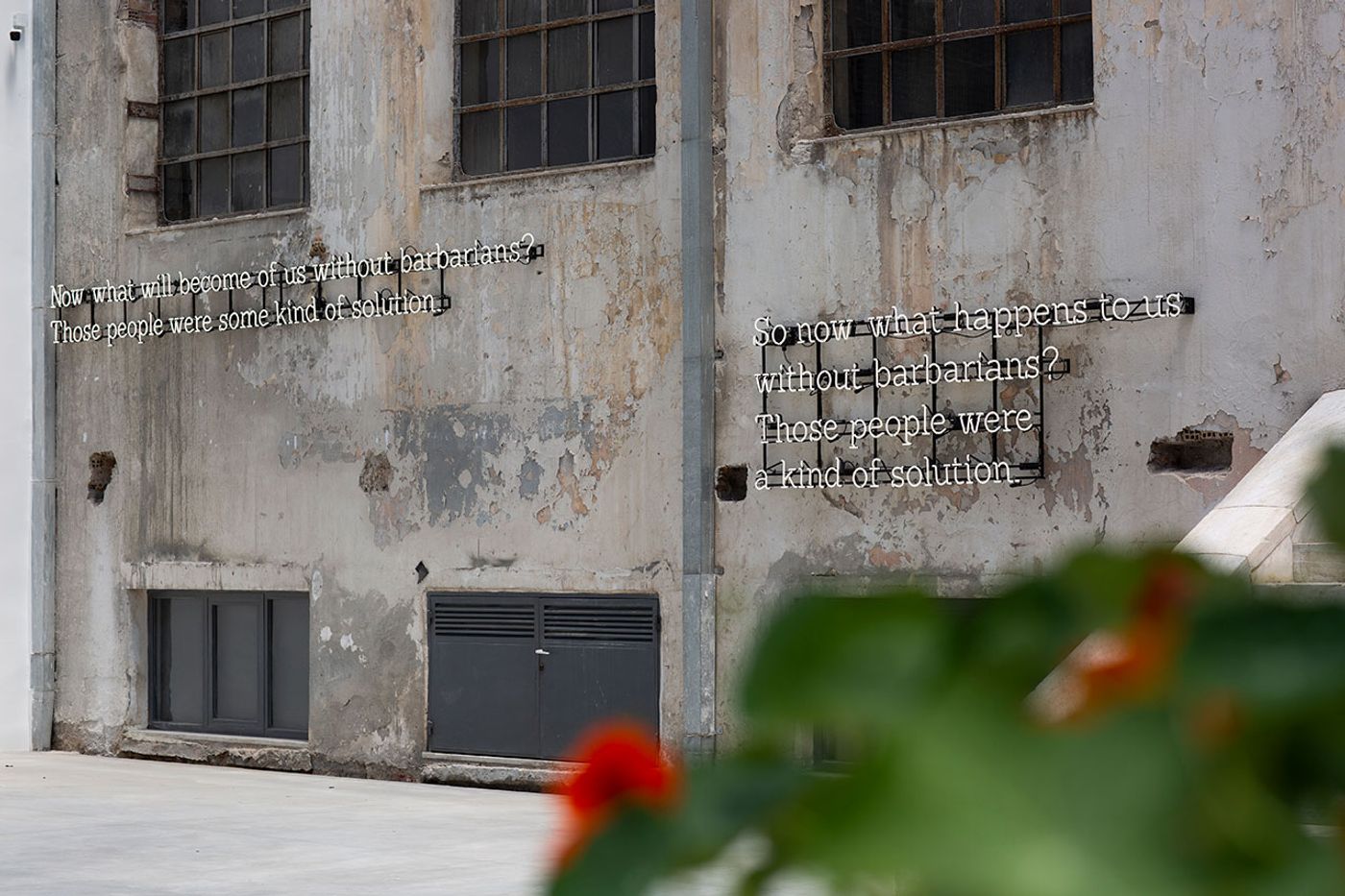
Installation View Portals, Hellenic Parliament + NEON at the former Public Tobacco Factory, Photography © Natalia Tsoukala. Courtesy NEON
Featured: Glenn Ligon, Waiting for the Barbarians (detail), 2021. Neon. Dimensions variable. Courtesy the artist and Thomas Dane Gallery Commissioned by NEON.
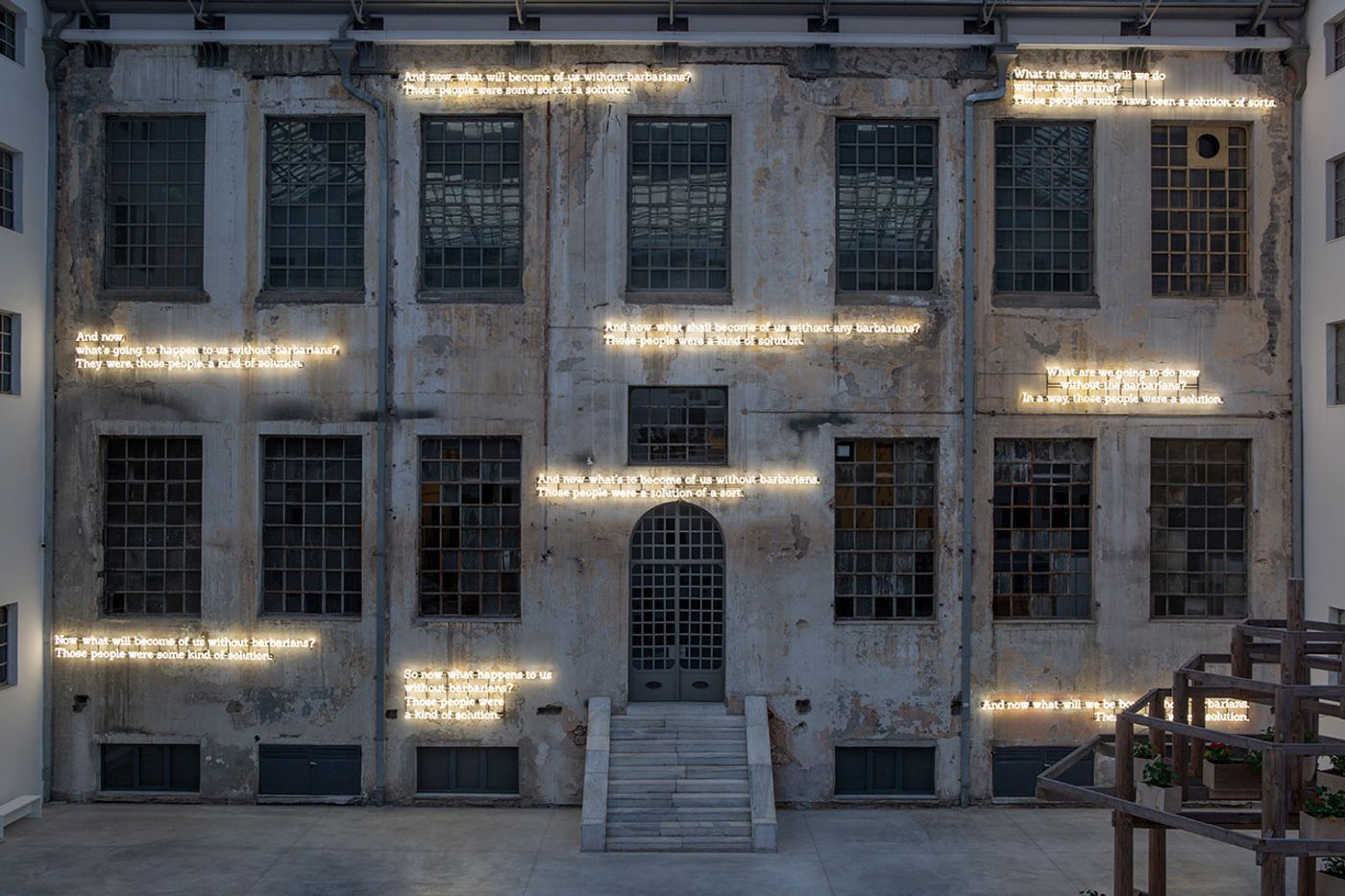
Installation View Portals, Hellenic Parliament + NEON at the former Public Tobacco Factory, Photography © Natalia Tsoukala. Courtesy NEON
Featured: Glenn Ligon, Waiting for the Barbarians (detail), 2021. Neon. Dimensions variable. Courtesy the artist and Thomas Dane Gallery Commissioned by NEON.
"Καί τώρα τί θα γένουμε χωρίς βαρβάρους. Οἱ ἄνθρωποι αὐτοί ἦσαν μιά κάποια λύσις." Κ. Π. Καβάφης, (2004). Ἃπαντα Ποιητικά. Αθήνα: Εκδόσεις ὕψιλον/βιβλία
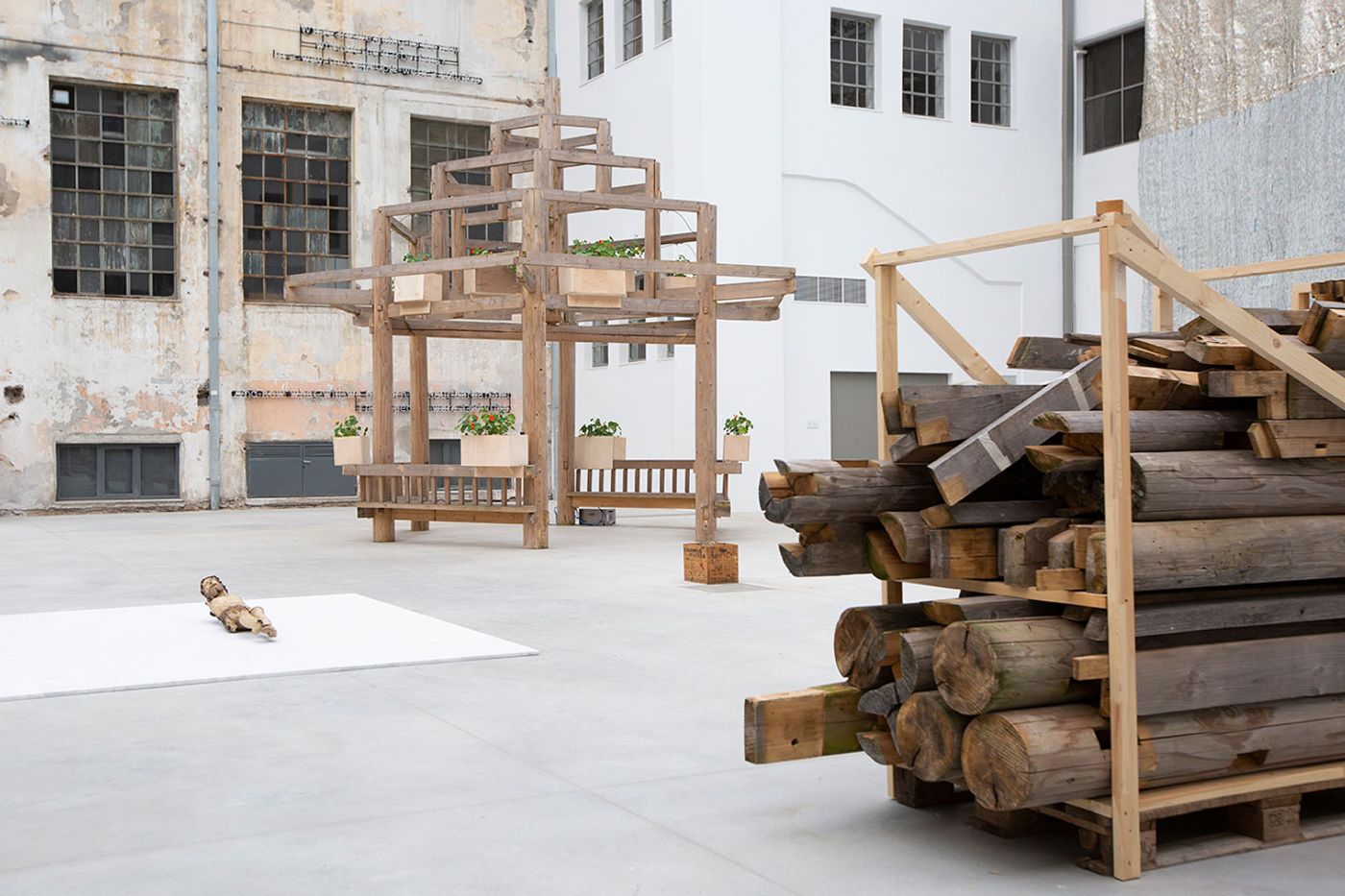
Installation View Portals, Hellenic Parliament + NEON at the former Public Tobacco Factory, Photography © Natalia Tsoukala. Courtesy NEON
Featured: Danh Võ, Untitled (detail), 2021. Mixed media Dimensions variable. Courtesy the artist. Commissioned by NEON

Installation View Portals, Hellenic Parliament + NEON at the former Public Tobacco Factory, Photography © Natalia Tsoukala. Courtesy NEON
Featured (front to back): Danh Võ, Untitled (detail), 2021. Mixed media Dimensions variable. Courtesy the artist. Commissioned by NEON. El Anatsui, Rising Sea, 2019. Aluminium and copper wire. 800 × 1400 cm. Courtesy the artist and Jack Shainman Gallery, New York.

Installation View Portals, Hellenic Parliament + NEON at the former Public Tobacco Factory, Photography © Natalia Tsoukala. Courtesy NEON
Featured: Danh Võ, Untitled (detail), 2021. Mixed media Dimensions variable. Courtesy the artist. Commissioned by NEON
In the corridor abutting the atrium, the works on display use language as an element of identity, negotiation or alienation. Mexican conceptual artist Teresa Margolles’ large collage of reproductions of newspaper covers from Ciudad Juárez, Mexico, conveys the brutality of reality, while the slogan-like texts painted on the walls by Cuban, US-based Felix Gonzalez-Torres mix personal and political messages. Further along, sculptural work by three generations of Brazilian female artists, Adriana Varejão, Sonia Gomes and Solange Pessoa explore the rich history of their country and colonialism.
In the former Customs Office, a site-specific installation by Nigerian fashion designer and artist Duro Olowu that mixes textural sculptures, painted work, video patterned wallpapers and wall lettering, explores ideas of migration and movement that aim to reveal hidden histories in politics and art, while in the bathroom area, a colourful, graphic mural by Argentine artist Ad Minoliti symbolically disrupts the separation between the two sexes as a reminder of the existence of other identities.
In one of the exhibition's larger rooms, Turkish artist Kutluğ Ataman and New York-based artist Adam Pendleton raise issues of social justice and racial equality, the former through a 40-channel video installation set up as a domestic setting where visitors get to sit down and watch an immersive sociological portrait of Küba, one of the most notorious ghettos in Istanbul which has been safeguarded by its inhabitants “from the rest of the society, state control and the rule of law which they deem to be unjust and corrupt” in the artist’s words. On his part, Pendleton presents a large group of framed Mylar transparencies in his signature “Black Dada” artistic practice, “a critical articulation of blackness, abstraction, and the avant-garde”, while work by the late Greek sculptor Jannis Kounellis nearby, echoes the working conditions of the industrial space.
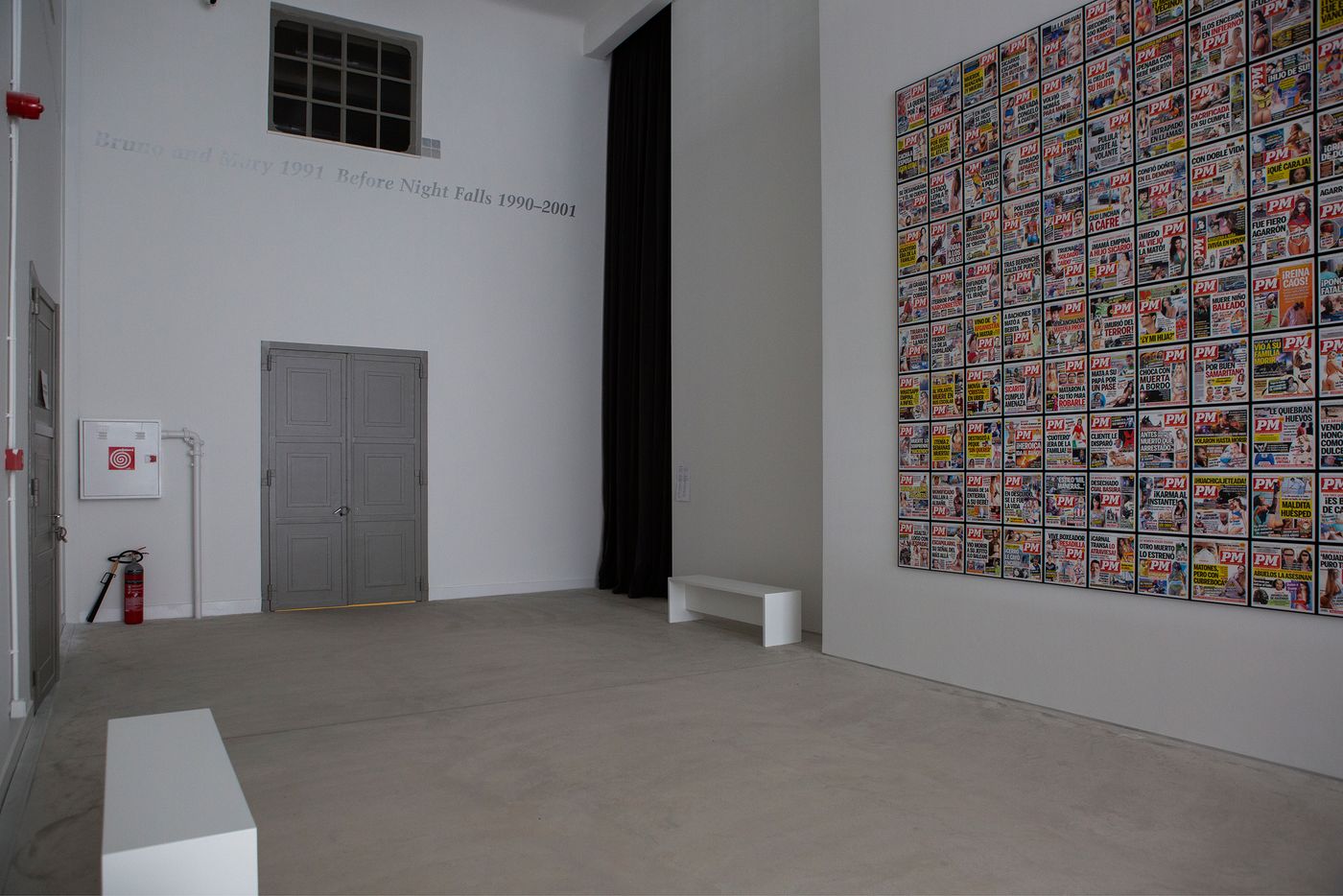
Installation View Portals, Hellenic Parliament + NEON at the former Public Tobacco Factory, Photography © Natalia Tsoukala. Courtesy NEON
Featured (from left): Felix Gonzalez-Torres, "Untitled", 1989. Paint on wall Dimensions vary with installation. The Art Institute of Chicago: bequest of Carolyn Spiegel; Watson F. Blair Prize, Muriel Kallis Newman, Sara Szold and Modern and Contemporary Discretionary funds; Samuel and Sarah Deson and Oscar L. Gerber Memorial endowments; and The San Francisco Museum of Modern Art, Accessions Committee Fund Purchase: gift of Jean and James E. Douglas Jr., Carla Emil and Rich Silverstein, Collectors Forum, Doris and Don Fisher, Niko and Steve Mayer, Elaine McKeon, and Danielle and Brooks Walker, Jr. Teresa Margolles, PM 2020, 2021. 314 print reproductions on photographic paper of covers of the evening newspaper PM from Ciudad Juárez, Mexico, published in 2020. 31 × 27.5 × 2 cm each (framed). Edition 1 of 3 +1 AP + 1 EC. Courtesy of the artist and James Cohan, New York Commissioned by NEON.

Installation View Portals, Hellenic Parliament + NEON at the former Public Tobacco Factory, Photography © Natalia Tsoukala. Courtesy NEON
Featured: Felix Gonzalez-Torres, "Untitled", 1989. Paint on wall Dimensions vary with installation. The Art Institute of Chicago: bequest of Carolyn Spiegel; Watson F. Blair Prize, Muriel Kallis Newman, Sara Szold and Modern and Contemporary Discretionary funds; Samuel and Sarah Deson and Oscar L. Gerber Memorial endowments; and The San Francisco Museum of Modern Art, Accessions Committee Fund Purchase: gift of Jean and James E. Douglas Jr., Carla Emil and Rich Silverstein, Collectors Forum, Doris and Don Fisher, Niko and Steve Mayer, Elaine McKeon, and Danielle and Brooks Walker, Jr.
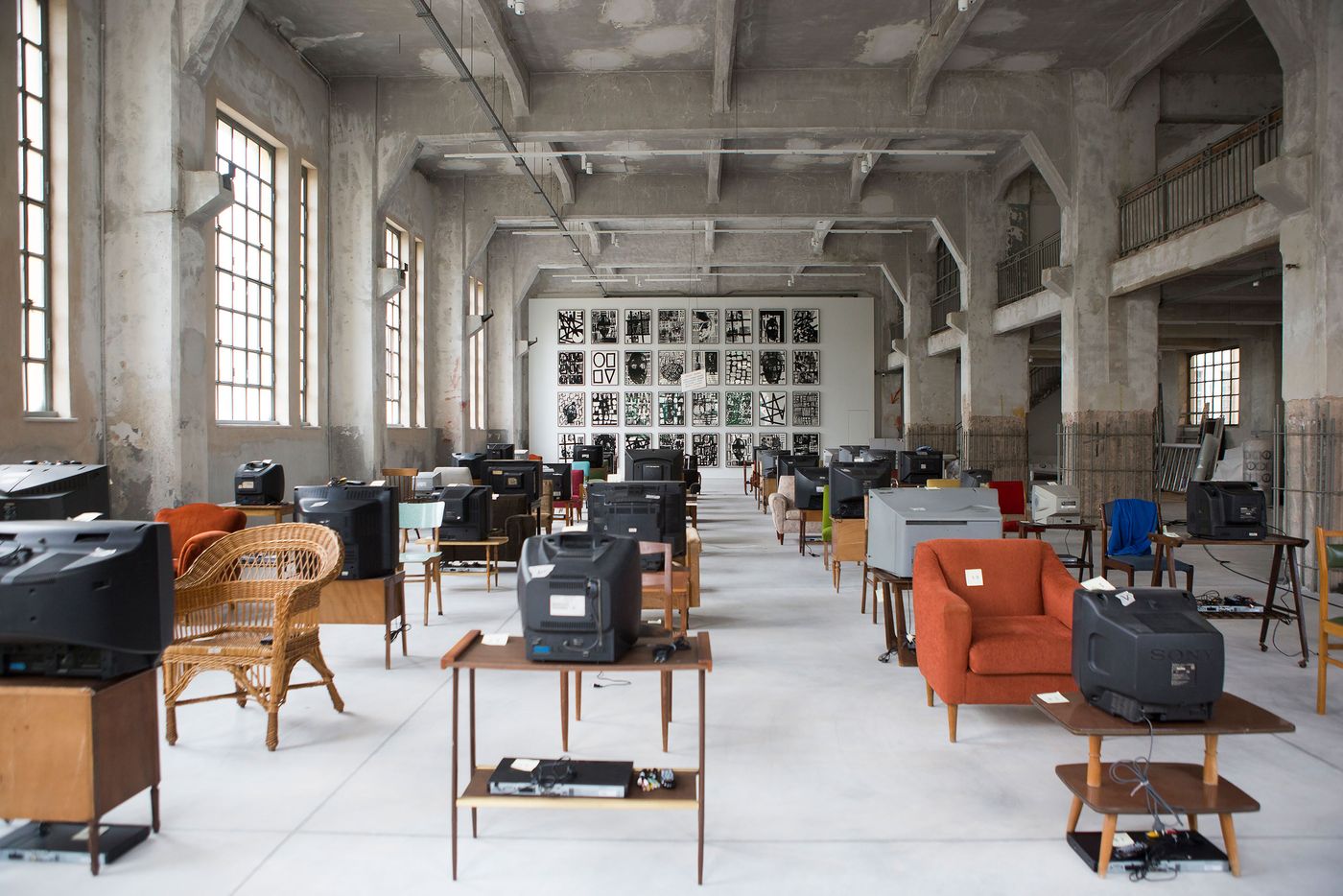
Installation View Portals, Hellenic Parliament + NEON at the former Public Tobacco Factory, Photography © Natalia Tsoukala. Courtesy NEON
Featured (front to back): Kutluğ Ataman, Küba, 2004. 40 channel video installation with sound, 40 used chairs, 40 tables, 40 television sets. Dimensions variable. D.Daskalopoulos Collection. Adam Pendleton, Our Ideas #2, 2018. Silkscreen ink on Mylar. Overall installation dimensions variable. 32 panels, 102.6 cm × 79.7 cm each, artist's frames. Courtesy of Yaacov Gorsd Collection. Art Consultancy Idit Orni
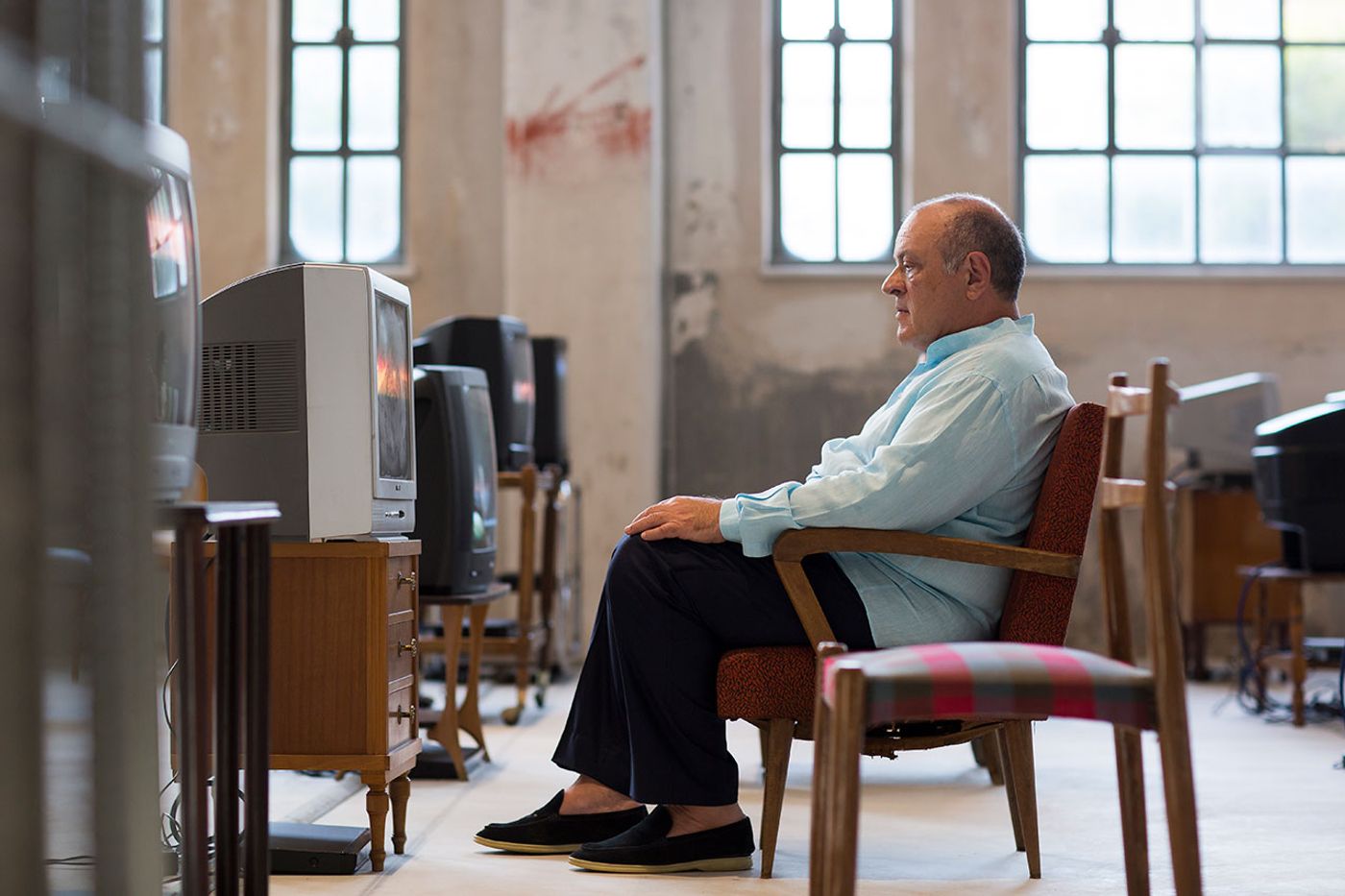
Installation View Portals, Hellenic Parliament + NEON at the former Public Tobacco Factory, Photography © Natalia Tsoukala. Courtesy NEON
Featured: Dimitris Daskalopoulos, ΝΕΟΝ Founder. Kutluğ Ataman, Küba, 2004. 40 channel video installation with sound, 40 used chairs, 40 tables, 40 television sets. Dimensions variable. D.Daskalopoulos Collection.
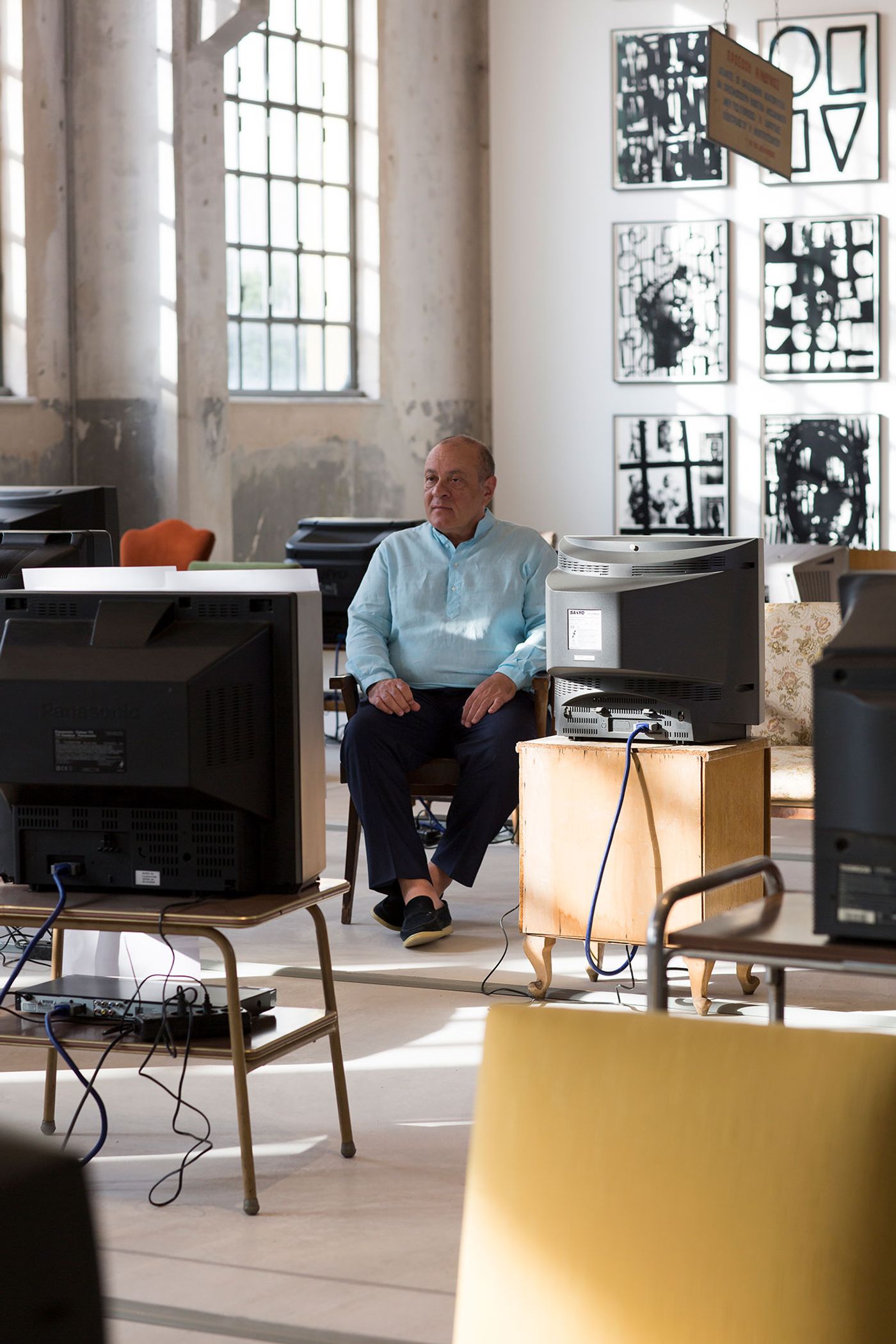
Installation View Portals, Hellenic Parliament + NEON at the former Public Tobacco Factory, Photography © Natalia Tsoukala. Courtesy NEON
Featured: Dimitris Daskalopoulos, ΝΕΟΝ Founder. Kutluğ Ataman, Küba, 2004. 40 channel video installation with sound, 40 used chairs, 40 tables, 40 television sets. Dimensions variable. D.Daskalopoulos Collection. Adam Pendleton, Our Ideas #2, 2018. Silkscreen ink on Mylar. Overall installation dimensions variable. 32 panels, 102.6 cm × 79.7 cm each, artist's frames. Courtesy of Yaacov Gorsd Collection. Art Consultancy Idit Orni

Installation View Portals, Hellenic Parliament + NEON at the former Public Tobacco Factory, Photography © Natalia Tsoukala. Courtesy NEON
Featured: Do Ho Suh, 348 West 22nd St., Apt. A & Corridor, New York, NY 10011, 2000-01. Translucent nylon. 245 × 598 × 1240 cm. D.Daskalopoulos Collection. Apostolos Georgiou, Untitled, 2020. Diptych, acrylic on canvas. 230 × 460 cm. Courtesy the artist and Rodeo, London / Piraeus.
On the mezzanine level, the exhibition touches on themes such as the development of informal networks and the power of social connections (whose relevance was highlighted during the pandemic-induced lockdowns), insecurity as a dystopian end to our common standard of living, and the concepts of trust and intimacy. The latter are explored through various representations of identity and home such as South Korean artist Do Ho Suh’s 348 West 22nd St., Apt. A & Corridor, New York, NY 10011, an installation that replicates to scale the artist’s New York apartment in baby blue and pink translucent polyester. Fusing traditional Korean sewing techniques with digital mapping tools, the maze-like installation, which visitors can walk through, is a physical manifestation of memory as well as a study on the malleability of space and the elusiveness of individuality. Monumental and yet unimposing, personal yet familial and intricately handcrafted yet technological advanced, Suh’s ethereal installation maps some of the contradictory forces behind the portals that the exhibition is curated around, and which, in the aftermath of the pandemic, we are individually and collectively being called upon to go through.
Running until December 31, 2021, after which the renovated space will be handed over to the Hellenic Parliament as a new culture hub, the ambitious project opens a new chapter in the building’s storied life as well as attests to NEON’s commitment to reinvigorating the country’s cultural landscape. Moreover, by sowing the seeds for a new, non-hierarchical kind of cultural institution, “a space where social and political strategies are rethought and reconstructed” as Kountouri says, the exhibition highlights the possibilities of a new, more equitable, pluralistic and humane post-pandemic normal - in other words, just what we individually and collectively need at the moment.

Installation View Portals, Hellenic Parliament + NEON at the former Public Tobacco Factory, Photography © Natalia Tsoukala. Courtesy NEON
Featured: Daphne Wright, Maple Row Sunflowers, 2019. Mixed media. 310 × 300 × 60 cm. Courtesy the artist and Frith Street Gallery, London.
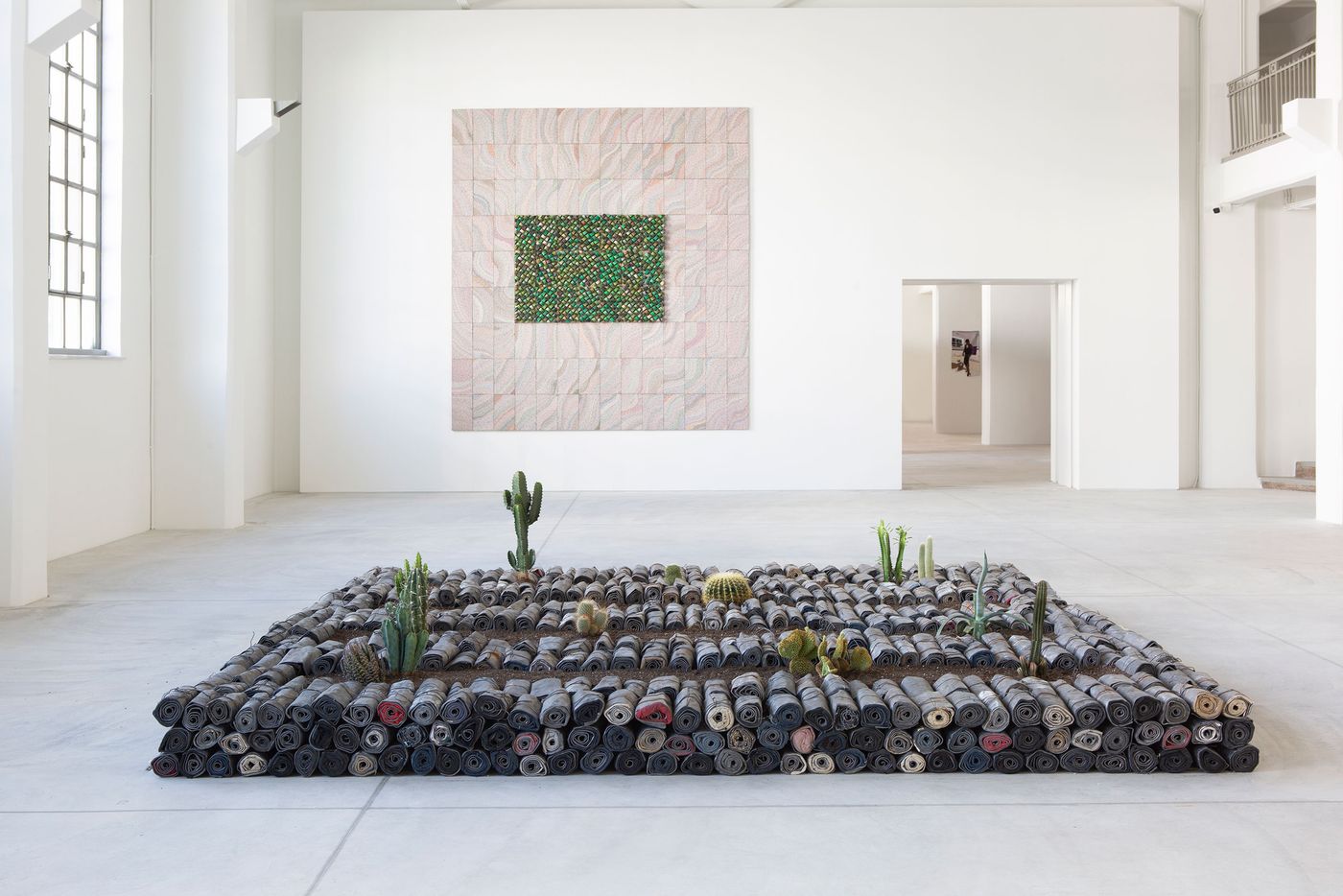
Installation View Portals, Hellenic Parliament + NEON at the former Public Tobacco Factory, Photography © Natalia Tsoukala. Courtesy NEON
Featured (front to back): Jannis Kounellis, Untitled, 2005. Lead, clothes, earth, cacti. 85 × 360 × 360 cm. Private Collection Rome, Italy. Elias Sime, TIGHTROPE: ECHO!?, 2020. Reclaimed electrical wire and components. 365.8 × 320 × 3.2 cm. Courtesy the artist and James Cohan, New York.
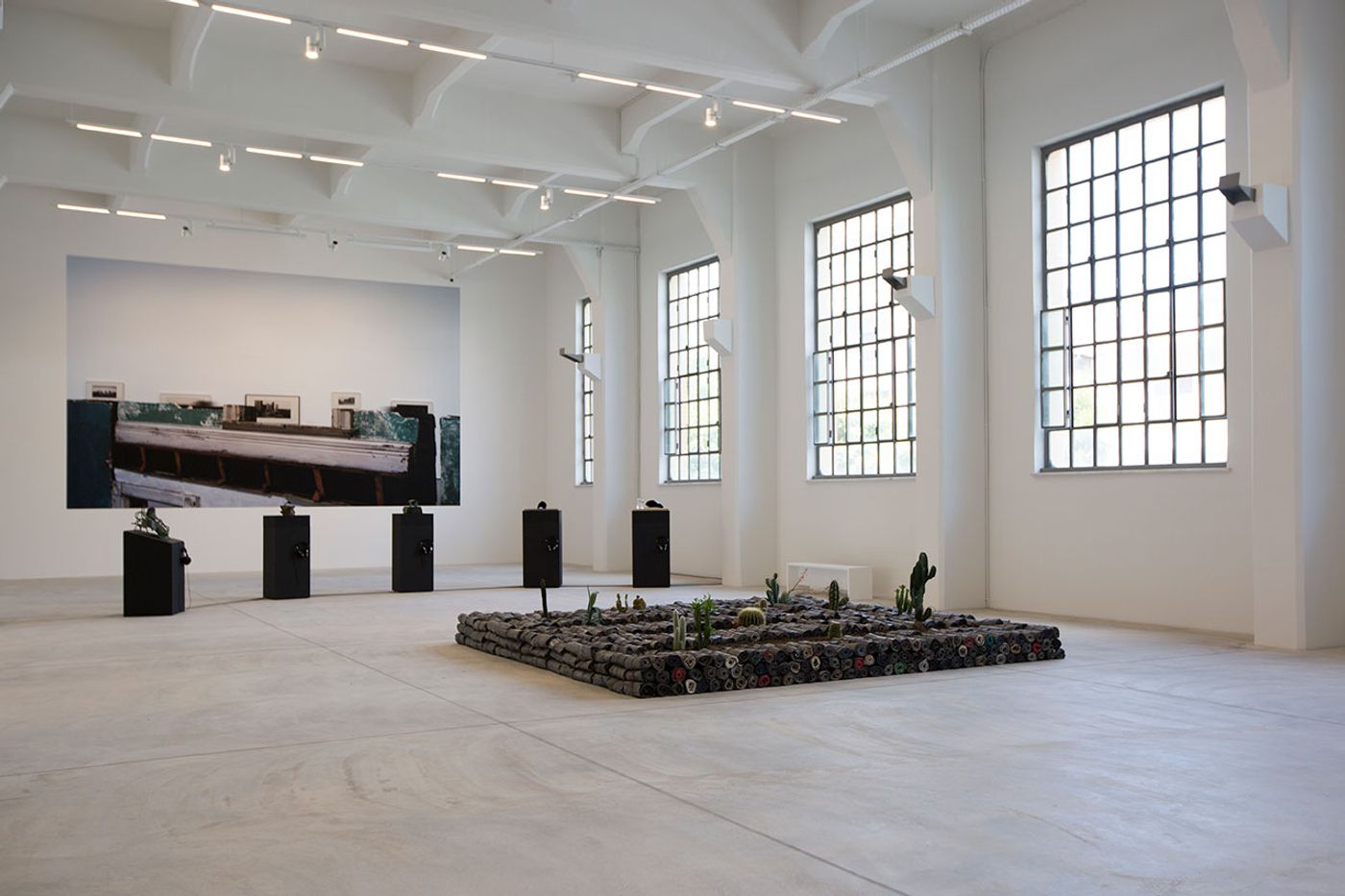
Installation View Portals, Hellenic Parliament + NEON at the former Public Tobacco Factory, Photography © Natalia Tsoukala. Courtesy NEON
Featured: Jannis Kounellis, Untitled, 2005. Lead, clothes, earth, cacti. 85 × 360 × 360 cm. Private Collection Rome, Italy. Liliane Lijn, Early Events, 1996-2000. Five sculptures, patinated bronze, freestanding painted MDF bases and media players. Dimensions variable Courtesy the artist and Rodeo, London / Piraeus. Louise Lawler, Cities (adjusted to fit), 2004/2005/2015. Adhesive wall material. Dimensions variable to match proportions of a given wall at any scale determined by exhibitor. Courtesy the artist, Metro Pictures, New York, Sprüth Magers.
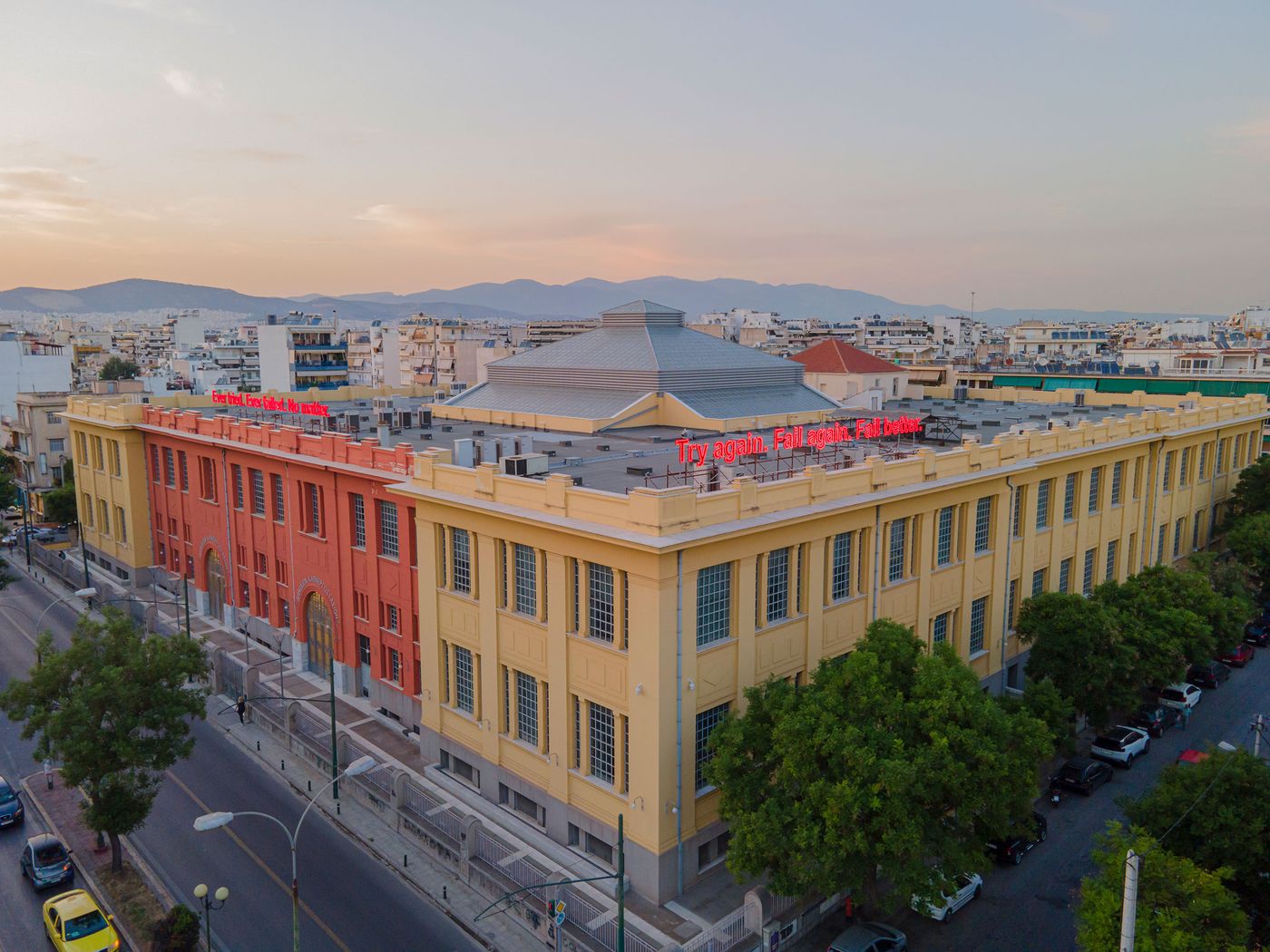
Installation View Portals, Hellenic Parliament + NEON at the former Public Tobacco Factory, Photography © Natalia Tsoukala. Courtesy NEON
Featured: Nikos Navridis, Try again. Fail again. Fail better, 2013. Galvanized sheet metal, oven paint, led light. 0.9 × 19.9 m each. Edition 2021. Courtesy the artist, NEON and Bernier/Eliades Gallery.